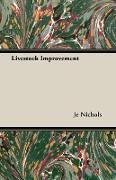Livestock Improvement
BücherAngebote / Angebote:
LIVESTOCK IMPROVEMENT IN RELATION TO HEREDITY AND ENVIRONMENT LIVESTOCK BY J. E. NICHOLS PREFACE FORMAL genetics does not always provide a satisfactory or convenient approach to an understanding1 of the principles involved in questions of livestock improvement and selection. The breeder finds it too remote at many stages from practical applications and bearings for the agricultural and veterinary student it usually follows too detached a route. The approach made here represents an attempt to outline the principles and to indicate how the genetic and environmental concepts are interwoven in the idea of stock improvement. The stimulus to make this attempt springs from discussions with my former colleagues and senior students in Western Australia, and with a great number of stockbreeders in many countries. If the topics of environment are surveyed in this book hTa predominantly ecological light, it is because my contacts with livestock industries have ranged widely my associations with practical breeders and livestock have been even, closer than those with geneticists dealing with laboratory or statistical material. For my part, I am deeply indebted to breeders for the facilities and help they have so freely given to enable me to realise that a vast laboratory, as yet little used exists in the field and on the range Moreover, my conviction grows that it is not only a task but alsoth duty of geneticists along with breeders, to seek those common meeting grounds on which the wider problems of livestock improvement and policies may be examined in broad perspective. Of the many breeders who have helped me to reach this point of view, Messrs A. L. B. and E. H. B. Lefroy must be among the first to accept my grateful acknowledgment of their encourage ment, enlarged by everready and acute criticism. My thanks are also due to Dr H. P. Donald for his generous help with the general and detailed presentation, to Professor R. G, White and Dr John Hammond for many valuable comments on matter and argument, to Dr P, C. Koller for his advice on the chromosome numbers given on p, 13, and to Dr John Hammond, Dr J. N, Pickard, Dr A. W. Greenwood, the Wool Industries Research Association, the Textile Institute, the Cambridge University Press, and Messrs Oliver and Boyd for kind permission to reproduce illustrations and diagrams. J. E. N. December 1943 CONTENTS CHAPTER PAGE I. GENERAL ASPECTS II. PARTICULAR PROBLEMS III. HOW INHERITANCE WORKS IV. GENE EFFECTS AND INTERACTIONS V. CUMULATIVE EFFECTS AND EXTERNAL FACTORS VI. GENE AND CHARACTER FREQUENCY VII. ENVIRONMENTAL ASPECTS VIII. GENETIC ASPECTS - 1. SELECTION IX. GENETIC ASPECTS - 2. INBREEDING AS A MATING SYSTEM X. GENETIC ASPECTS - 3. LINEBREEDING XI. OUTBREEDING AND HYBRID VIGOUR XII. MATING LIKES AND UNLIKES. XIII. PERFORMANCE AND PROGENY TESTING XIV. BREED CONSTRUCTION XV. TYPE AND ENVIRONMENT REFERENCES INDEX
Folgt in ca. 10 Arbeitstagen
